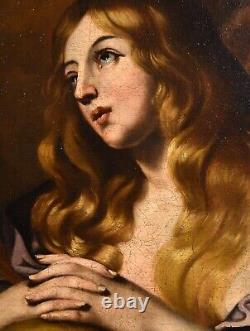
- Index
- Listed By
- Material
- Size
- Style
- Abstract (20)
- Abstract, Modernism (6)
- Americana (5)
- Art Deco (9)
- Art Nouveau (4)
- Art, Realism (4)
- Dutch (4)
- Dutch, Realism (5)
- Expressionism (23)
- Folk Art (9)
- Impressionism (150)
- Impressionist (5)
- Modernism (12)
- Portraiture (6)
- Realism (163)
- Still Life (22)
- Traditional (10)
- Traditional, Realism (4)
- Victorian (18)
- Vintage (58)
- Other (476)
- Subject
- Unit Of Sale
Large Painting Antique Tan Oil on Canvas 17/18 Century Old Master Italy

















Large Painting Antique Tan Oil on Canvas 17/18 Century Old Master Italy. The description of this item has been automatically translated. Circle of Francesco Trevisani (Capodistria 1656 - Rome 1746). Oil on canvas 100 x 81 cm. With frame 112 x 92 cm.
Full details of this painting can be consulted directly at the following - links. The protagonist of the work is a seductive Saint Mary Magdalene, semi-nude to recall her past as a sinner, with long hair with blond reflections that descend on her body covering her breasts, and her gaze full of emotion turned towards the sky, to evoke the repentance. Next to her the skull, the cross and the open book, the three canonical symbols of her iconography. She is depicted in a penitent attitude, with her hands joined in prayer and absorbed in meditation, but at the same time characterized by an overwhelming femininity, exalted by her semi-nudity, dressed only in a drape softly supported by her arms. She is therefore portrayed with the typical ambivalence between the sacred and the profane that identifies her figure, in a perfect balance between the sensuality of the sinner and her spiritual asceticism in repentance. Although the canvas is still undergoing in-depth study, it is not difficult to grasp the superb mastery of its author, active around the end of the seventeenth century, from which we can deduce a drawing culture of Roman origin, in which French and even Venetian echoes converge.On the basis of these considerations, combined with features such as the precision of the drawing, the extraordinary spreading of the surfaces, almost glazed, and the clear color definition, we are inclined to attribute our work to the hand of Francesco Trevisani and his circle (1656 - 1746). In particular, the analogies with the work of the master are strong, a fundamental reference for many artists of the second half of the seventeenth century in Rome and an object of study and inspiration still current in the eighteenth century. The elegant ease of touch and the sensual refinement typical of Trevisani, combined with a very accurate chiaroscuro rendering, inherited from his artistic training in Venice, and the exceptional sweetness of the drawing, the floridity of the complexion, and finally, the peculiar pose of the portrayed figure (the unmistakable beauty of the two intertwined hands), further corroborate our attribution. From the dark nocturnal background, a direct light is released to centralize the Saint, illuminating her face and body: this is how the perfectly studied luministic rendering brings out the shapes of her body, modeled to enhance her exuberant sensuality. The conditions of the painting are excellent.
It is also possible to see the painting in the Riva del Garda gallery, we will be happy to welcome you to show you our collection of works. The elegant ease of touch and the sensual refinement typical of Trevisani, combined with a very accurate chiaroscuro rendering, inherited from his artistic training in Venice, and the exceptional sweetness of the drawing, the floridity of the complexion, and fi. Cerchia di Francesco Trevisani (Capodistria 1656 - Roma 1746).
